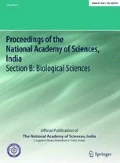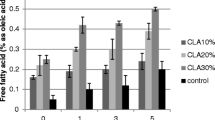Abstract
Two newly developed low erucic acid containing varieties of Indian mustard (RLC 3) and rapeseed (GSC 7) were evaluated for cooking quality. Oils extracted from these varieties were analyzed for physicochemical properties, fatty acid composition, antioxidants and oxidative stability. Consequently, GSC 7 had the highest smoke point (234.3 °C) and was the most stable cooking oil in terms of chemical parameters. The highest value of oleic acid was observed in the RLC 3 oil (66.1%), and the lowest value of erucic acid was observed in the GSC 7 oil (0.5%). GSC 7 oil contained higher value of total antioxidants (616.3 mg/kg). The food products prepared using GSC 7 oil were found to be more stable on the basis of analytical parameters. The study recommends that varieties of canola may be promoted to increase its availability at affordable price.

Similar content being viewed by others
References
Kumar A, Sharma P, Thomas L, Agnihotri A, Banga SS (2009) Canola cultivation in India: scenario and future strategy. In: 16th Australian research assembly on Brassicas, Ballarat Victoria, pp 1–5
Vetter W, Darwisch V, Lehnert K (2020) Erucic acid in Brassicaceae and salmon—an evaluation of the new proposed limits of erucic acid in food. NFS Journal 19:9–15
Sandhu S, Kaur G (2018) Punjab state—the potential canola oil hub of country. Presented at SEA Rapeseed-Mustard conclave, Jaipur, India
AOAC (2000) Oils & fats. In: William H (ed) Official methods of analysis of AOAC international. USA, AOAC International, pp 1–69
JCAM (2013) Quantitative analysis of vitamin E in vegetable oils. Jpn Customs Anal Methods 107:R3
Gao G, Xiaoming WU, Guangyuan LU, Biyun C, Kun XU (2007) Analysis of carotenoid in seed of several oil crops. In: Proceedings of the 12th international rapeseed congress, V, pp 82–84
Choudhary M, Grover K, Kaur G (2015) Development of rice bran oil blends for quality improvement. Food Chem 173:770–777
Appleqvist LÅ (1968) Rapid methods of lipid extraction & fatty acid ester preparation for seed & leaf tissue with special remarks on preventing the accumulation of lipid contaminants. Ark Kenci 28:351–370
AOCS (2003) Sampling & analysis of commercial fats & oils. AOCS official method Cd 8-53 surplus peroxide value acetic acid–chloroform method definition. USA, AOCS Cold Spring Harbour
Berger GK (2005) Frying oil series—the use of palm oil in frying. Malaysia, Malaysian palm oil promotion council pp 4–113
Muhammad N, Bamishaiye E, Bamishaiye O, Usman L, Salawu M, Nafiu M, Oloyede O (2011) Physicochemical properties and fatty acid composition of cyperus esculentus (Tiger nut) Tuber Oil. Biores Bull 5:51–54
Rahman MH, Rahman SS, Nasreen L, Begum UH, Rahman YM, MN, (2017) Biochemical properties and chromatographic investigation of rape seed oils in Bangladesh. Int J Nutr Metabol 9:48–57
Richards A, Wijesundera C, Salisbury P (2008) Genotype and growing environment effects on the tocopherols and fatty acids of Brassica napus and Brassica juncea. J Am Oil Chem Soc 85:159–168
Abidi S, List G, Rennick K (1999) Effect of genetic modification on the distribution of minor constituents in canola oil. J Am Oil Chem Soc 76:463–467
Dolde D, Vlahakis C, Hazebroek J (1999) Tocopherols in breeding lines and effects of planting location, fatty acid composition and temperature during development. J Am Oil Chem Soc 76:349–355
National Academy of Sciences (2000) Report of the panel on dietary reference intakes for vitamin C, vitamin E, selenium and carotenoids. Food and Nutrition Board, National Academy Press, Washington, p 187
Cho K, Mabasa L, Fowler AW, Walsh DM, Park CS (2010) Canola oil inhibits breast cancer cell growth in cultures and in vivo and acts synergistically with chemotherapeutic drugs. Lipids 45:777–784
Bhatia E, Doddivenaka C, Zhang X (2011) Chemo-preventive effects of dietary canola oil on colon cancer development. Nutr Cancer 63:242–247
Antova GA, Angelova-Romova MI, PetkovaZh Y, Teneva OT, Marcheva P (2017) Lipid composition of mustard seed oils (Sinapis alba L.). Bulgar Chem Commun 49:55–60
Dorni C, Sharma P, Saikia G, Longvah A (2018) Fatty acid profile of edible oils and fats consumed in India. Food Chem 238:9–15
Kotlyarov S, Kotlyarova A (2022) Involvement of fatty acids and their metabolites in the development of inflammation in atherosclerosis. Int J Mol Sci 23:1308
Nikzad N, Ghavami M, Seyedain-Ardabili M, Akbari-Adergani B, Azizinezhad R (2021) Effect of deep frying process using sesame oil, canola and frying oil on the level of bioactive compounds in onion and potato and assessment of their antioxidant activity. Food Sci Technol Campinas 41:545–555
Szabo Z, Marosvölgyi T, Szabo E, Koczka V, Verzar Z, Figler M, Decsi T (2022) Effects of repeated heating on fatty acid composition of plant-based cooking oils. Foods 11:192
Choudhary M, Grover K, Javed M (2015) Effect of deep-fat frying on fatty acid composition and iodine value of rice bran oil blends. Proc Natl Acad Sci India Sect B Biol Sci 85:211–218
Burton WA, Pymer SJ, Salisbury PA, Kirk JTO, Oram RN (1999) Performance of Australian canola quality Indian mustard breeding lines. In: Proceedings 10th international rapeseed congress, Canberra, Australia
Alireza S, Tan CP, Hamed M, Che Man YB (2010) Effect of frying process on fatty acid composition and iodine value of selected vegetable oils and their blends. Int Food Res J 17:295–302
Fullana A, Carbonell-Barrachina AA, Sidhu S (2004) Volatile aldehyde emissions from heated cooking oils. J Sci Food Agric 84:2015–2021
Mariod AA, Ali RT, Ahmed YM, Abdelwahab ST, Abdul AB (2010) Effect of the method of processing on quality oxidative stability of anhydrous butter fat (Samm). Afr J Biotechnol 9:1046–1051
Ranganna S (2005) Handbook of analysis and quality control for fruit and vegetable products. Mc-Graw Hill, New Delhi
Pokorny J, Panek J (2012) The effect of natural antioxidants in herbs and spices on food and shelf-life. In: Peter KV (ed) Handbook of herbs and spices. Woodhead Publishing, Sawston, pp 51–71
Acknowledgements
The authors are thankful to the Oilseed section, Department of Plant Breeding and Genetics, Punjab Agricultural University, Ludhiana, for providing infrastructural facilities for fatty acid analysis.
Author information
Authors and Affiliations
Corresponding author
Ethics declarations
Conflict of interest
The authors declare that they have no conflict of interest.
Additional information
Publisher's Note
Springer Nature remains neutral with regard to jurisdictional claims in published maps and institutional affiliations.
Significance Statement Low erucic GSC 7 Brassica oil found as the most stable and healthiest cooking oil among PBR 357, RLC 3and GSL 1 cultivars.
Rights and permissions
About this article
Cite this article
Saklani, S., Grover, K., Choudhary, M. et al. Fatty Acid Composition and Oxidative Potential of Food Products Prepared Using Low Erucic Brassica Oils. Proc. Natl. Acad. Sci., India, Sect. B Biol. Sci. 93, 107–117 (2023). https://doi.org/10.1007/s40011-022-01415-6
Received:
Revised:
Accepted:
Published:
Issue Date:
DOI: https://doi.org/10.1007/s40011-022-01415-6




